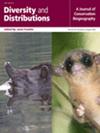Biodiversity Congruence Across Lake-Watershed Landscapes: Insights From an Analysis of 615 Canadian Sites
Abstract
Aim
The rapid decline in freshwater biodiversity and growing disturbances in adjacent terrestrial systems (deforestation, wetland destruction, etc.) are threatening the status of watershed ecosystems. This study focuses on both the aquatic and terrestrial realms to provide a general assessment of the health and integrity of biodiversity across 12 ecozones in Canada. The goal is to improve our assessment of geographical trends in Canadian watersheds and to provide support in the decision making for land use planning.
Location.
615 Canadian lake watersheds, spanning across 12 ecozones.
Methods
We used species richness and Shannon's biodiversity metrics to quantify and map trends in phytoplankton, zooplankton and trees across Canada. A series of generalised additive models (GAMs), one-way ANOVA, and Tukey HSD tests were conducted to investigate the relationship between aquatic and terrestrial biodiversity and the spatial trend of biodiversity across ecozones. Lastly, a series of multivariate regression tree (MRT) analyses were performed to investigate the relationship between land use, environmental variables and watershed biodiversity.
Results
Total watershed biodiversity followed a longitudinal pattern, where biodiversity estimates were greatest across the eastern ecozones of Canada and lowest in central-western Canada (e.g., Prairies). We found moderately positive relationships between aquatic and tree biodiversity that varied across the different ecozones and were generally strongest across eastern ecozones. Results from the MRTs revealed total watershed biodiversity correlated positively with the proportion of natural landscapes and precipitation and negatively with the proportion of agricultural area.
Main Conclusion.
Our findings provide a better understanding of broad-scale watershed biodiversity trends and distribution, which are strongly influenced by the North American elevation gradient and longitudinal patterns of climatic conditions (e.g., precipitation). We found the proportion of agricultural area to be the variable with the strongest negative correlation with biodiversity. These results provide a first portrait of cross-ecosystem diversity trends in Canada and a key resource for large-scale land use planning and climate change mitigation efforts.


 求助内容:
求助内容: 应助结果提醒方式:
应助结果提醒方式:


